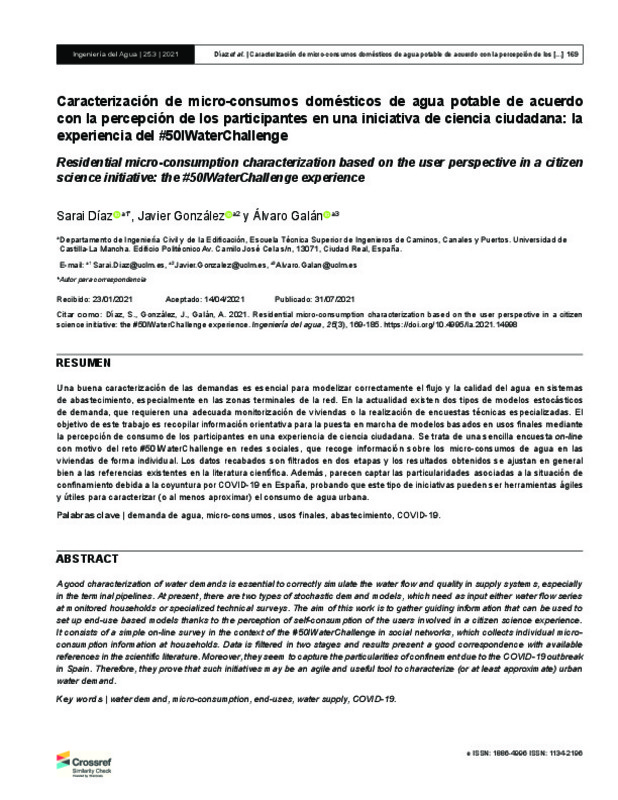Blokker, E.J.M., Pieterse-Quirijns, E., Vreeburg, J., van Dijk, J. 2011. Simulating nonresidential water demand with a stochastic end-use model. Journal of Water Resources Planning and Management, 137(6), 511-520. https://doi.org/10.1061/(ASCE)WR.1943-5452.0000146
Blokker, E.J.M., Vreeburg, J., Buchberger, S., van Dijk, J. 2008. Importance of demand modelling in network water quality models: A review. Drinking Water Engineering and Science, 1(1), 27-38. https://doi.org/10.5194/dwes-1-27-2008
Blokker, E.J.M., Vreeburg, J., van Dijk, J. 2010. Simulating residential water demand with a stochastic end-use model. Journal of Water Resources Planning and Management, 136(1), 19-26. https://doi.org/10.1061/(ASCE)WR.1943-5452.0000002
[+]
Blokker, E.J.M., Pieterse-Quirijns, E., Vreeburg, J., van Dijk, J. 2011. Simulating nonresidential water demand with a stochastic end-use model. Journal of Water Resources Planning and Management, 137(6), 511-520. https://doi.org/10.1061/(ASCE)WR.1943-5452.0000146
Blokker, E.J.M., Vreeburg, J., Buchberger, S., van Dijk, J. 2008. Importance of demand modelling in network water quality models: A review. Drinking Water Engineering and Science, 1(1), 27-38. https://doi.org/10.5194/dwes-1-27-2008
Blokker, E.J.M., Vreeburg, J., van Dijk, J. 2010. Simulating residential water demand with a stochastic end-use model. Journal of Water Resources Planning and Management, 136(1), 19-26. https://doi.org/10.1061/(ASCE)WR.1943-5452.0000002
Buchberger, S., Wells, G. 1996. Intensity, duration and frequency of residential water demands. Journal of Water Resources Planning and Management, 122(1), 11-19. https://doi.org/10.1061/(ASCE)0733-9496(1996)122:1(11)
Buchberger, S., Wu, L. 1995. Model for instantaneous residential water demands. Journal of Hydraulic Engineering, 121(3), 232-246. https://doi.org/10.1061/(ASCE)0733-9429(1995)121:3(232)
Canfield, D.E., Brown, C.D., Bachmann, R.W., Hoyer, M.V. 2002. Volunteer lake monitoring: testing the reliability of data collected by the Florida LAKEWATCH Program. Lake and Reservoir Management, 18(1), 1-9. https://doi.org/10.1080/07438140209353924
Creaco, E., Blokker, E.J.M., Buchberger, S. 2017. Models for generating household water demand pulses: Literature review and comparison. Journal of Water Resources Planning and Management, 143(6), 04017013. https://doi.org/10.1061/(ASCE)WR.1943-5452.0000763
Cubillo, F., Moreno, T., Ortega, S. 2008. Microcomponentes y factores explicativos del consumo doméstico de agua en la Comunidad de Madrid. Cuaderno de I+D+i 4, Canal de Isabel II, Madrid, España.
Darwall, W.R.T., Dulvy, N.K. 1996. An evaluation of the suitability of non-specialist volunteer researchers for coral reef fish surveys. Mafia Island, Tanzania - a case study. Biological Conservation, 78(3), 223-231. https://doi.org/10.1016/0006-3207(95)00147-6
Díaz, S., González, J. 2020. Analytical Stochastic Microcomponent modeling approach to assess network spatial scale effects in water supply systems. Journal of Water Resources Planning and Management, 146(8), 04020065. https://doi.org/10.1061/(ASCE)WR.1943-5452.0001237
Díaz, S., González, J. 2021. Temporal scale effect analysis for water supply systems monitoring based on a microcomponent stochastic demand model. Journal of Water Resources Planning and Management, 147(5), 04021023. https://doi.org/10.1061/(ASCE)WR.1943-5452.0001352
Díaz, S., Mínguez, R., González, J. 2016. Stochastic approach to observability analysis in water networks. Ingeniería del Agua, 20(3), 139-152. https://doi.org/10.4995/ia.2016.4625
Dickinson, J.L., Zuckerberg, B., Bonter, D.N. 2010. Citizen science as an ecological research tool: challenges and benefits. Annual Review of Ecology, Evolution and Systematics, 41, 149-172. https://doi.org/10.1146/annurev-ecolsys-102209-144636
Domene, E., Saurí, D., Martí, X., Molina, J., Huelin, S. 2009. Tipologías de vivienda y consumo de agua en la región metropolitana de Barcelona. Fundación Nueva Cultura del Agua, Zaragoza, España.
Filion, Y., Karney, B., Moughton, L., Buchberger, S., Adams, B. 2008. Cross correlation analysis of residential water demand in the city of Milford, Ohio. Proceedings of the Water Distribution Systems Analysis Symposium 2006, August 27-30, Cincinnati, USA. https://doi.org/10.1061/40941(247)43
Follet, R., Strezov, V. 2015. An analysis of citizen science based research: usage and publication patterns. PLOS ONE, https://doi.org/10.1371/journal.pone.0143687
INE. 2018. INEbase > Agricultura y medio ambiente > Agua > Estadística sobre el suministro y saneamiento del agua: consulta 19 Enero 2021. Disponible en https://www.ine.es/dyngs/INEbase/es/operacion.htm?c=Estadistica_C&cid=1254736176834&menu=ultiDatos&idp=1254735976602 [Último acceso 08/04/2021]
INE. 2020. INEbase > Demografía y población: consulta 25 Julio 2020. Disponible en https://www.ine.es/dyngs/INEbase/es/categoria.htm?c=Estadistica_P&cid=1254734710984 [Último acceso 08/04/2021]
Irwin, A. 1995. Citizen science: A study of people, expertise and sustainable development. Taylor & Francis, London, UK. https://doi.org/10.4324/9780203202395
Krabbenhoft, C.A., Kashian, D.R. 2020. Citizen science data are a relative complement to quantitative ecological assessments in urban rivers. Ecological Indicators, 116, 106476. https://doi.org/10.1016/j.ecolind.2020.106476
Magini, R., Pallavicini, I., Guercio, R. 2008. Spatial and temporal scaling properties of water demand. Journal of Water Resources Planning and Management, 134(3), 276-284. https://doi.org/10.1061/(ASCE)0733-9496(2008)134:3(276)
Ministerio de Fomento. 2019. Documento Básico HS: Salubridad. Ministerio de Fomento, Madrid, España.
Pastor-Jabaloyes, L., Arregui, F.J., Cobacho, R. 2018a. Simplifying water consumption flow traces for improving end use recognition: a case study. Ingeniería del Agua, 22(4), 195-208. https://doi.org/10.4995/ia.2018.9476
Pastor-Jabaloyes, L., Arregui, F.J., Cobacho, R. 2018b. Water end use disaggregation based on soft computing techniques. Water, 10(1), 46. https://doi.org/10.3390/w10010046
Peñalver, P.L., García, P., Pérez, V., Sánchez del Rivero, J.A., Díaz, R., Lastra, J., García, S. 2017. Sistema de reconocimiento de patrones para identificación de usos finales del agua en consumos domésticos. Cuaderno de I+D+i 25, Canal de Isabel II, Madrid, España.
Red 4C. 2021. Disponible en https://red4c.es/ [Último acceso 08/04/2021]
Senabre, E., Ferran-Ferrer, N., Perelló, J. 2018. Diseño participativo de experimentos de ciencia ciudadana. Revista Científica de Educomunicación, 54(26), 29-38. https://doi.org/10.3916/C54-2018-03
[-]









